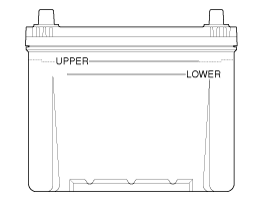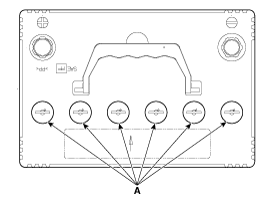Check that the electrolyte level lies between the “UPPER” and the “LOWER” lines.

In general, vehicle battery charging system has three forms.
Constant current charge: The battery voltage gradually rises by charging with setting a constant current. If charging current and time are not managed correctly, the battery is over-charged, therefore charging should be stopped after confirming the completion of charging.
General charge: Charging the battery for a long time with low current
Quick charge: Charging the battery for a short time with high current
Constant voltage charge: The battery charge current is gradually reduced by charging with setting a constant voltage.
Constant current-Constant voltage charge: Charging with constant current and voltage to protect the battery damage
Initial Stage: Charging with constant current
Last Stage: Charging with constant voltage
Refer to the instruction manual provided by the battery charger equipment manufacturers for detailed charging procedures and precautions.
[AGM Battery Charging]
AGM battery should be charged with constant voltage or constant current-constant voltage in order to minimize performance degradation due to the charging.
If charging the battery with constant current, overcharging may occur. It can cause damage to the internal battery and will give an adverse effect on battery life.
Do not charge with more than 14.8V or quick charge mode.
[Constant Voltage Charge Conditions]
Charging voltage / time: 14.7V [68°F ~ 86°F (20°C ~ 30°C)] / approximately 24 hours
The minimum charge voltage: 14.4V [68°F ~ 86°F (20°C ~ 30°C)]
The maximum charging voltage: 14.8V [68°F ~ 86°F (20°C ~ 30°C)]
Battery temperature should be maintained at about 68°F ~ 86°F (20°C ~ 30°C) during charging of the battery.
If the battery is charged directly at the battery terminals on vehicles with battery sensor, misinterpretations of battery condition and under certain circumstances also unwanted Check Control messages or fault memory entire can occur.
After recharging finished, let the battery stand for over 10 hours with normal temperature for battery stabilization.
Check that the electrolyte level lies between the “UPPER” and the “LOWER” lines.

If the electrolyte level is below the "LOWER" line, add water until the level of electrolyte comes up to the "UPPER" level.
Remove the cell caps (A) and then carefully add distilled or purified water to bring the level of electrolyte in each cell to the "UPPER" line.
Put the cell caps back on the battery.
Charge the battery to mix the water and residual acid in the battery.
Never use the water with impurities or additives to fill the battery cells. It will reduce the life and performance of the battery.
Do not overfill the battery cells. It may result in an "overflow" of the acid electrolyte and cause corrosion on adjacent metal parts, performance deterioration and shortening the life span.
Make sure the cell caps are installed securely before charging the battery after filling the battery cells.
